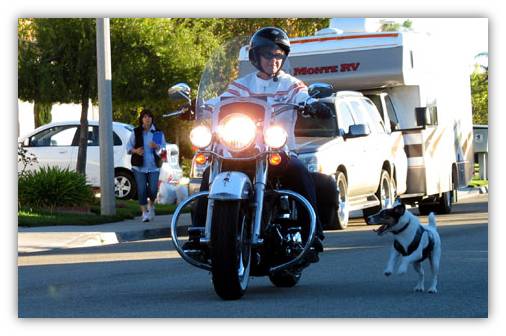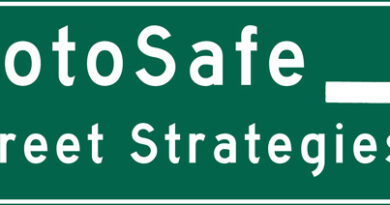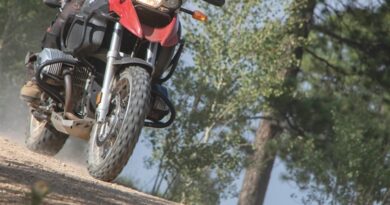Street Strategies: Animals!
Recently, while reading David Hough’s book Proficient Motorcycling, I began to think about how animals of all kinds create problems for us as we ride. In the Basic Rider classes, we spend only a small amount of time discussing how we as motorcyclists interact with animals. The summer months are upon us and soon it will turn to fall, we are going to be spending a lot of time on roads with all kinds of animals near and/or on the road.
How do we prepare ourselves to handle those situations where we MUST interact in some way with those animals? Interactions with animals are inevitable. Deer, dogs, bears, birds: They all can ruin our daily ride. We need to be prepared, as different animals require different strategies.
Deer
Anyone who has driven a car along a wooded stretch of road in the twilight hours knows about deer. Whitetail, blacktail or mule deer, they all exhibit similar behavior, best described as erratic and unpredictable. When you see the road sign that indicates the presence of deer, the best strategy is to slow down! I am sure many of you have stories of deer encounters. How the deer stopped in the middle of the road, then jumped back the way it had come. How the deer paused on the side of the road, looking straight at you, then jumped across the road in front of you. On and on we hear stories of how deer have surprised us. The best strategy is first, slow down when you see that sign.
 Next, scan ahead and to the sides, more than you would normally. If you see deer, stop and wait until they leave the road area. Proceed slowly past where you saw them, being prepared for them to jump back out.
Next, scan ahead and to the sides, more than you would normally. If you see deer, stop and wait until they leave the road area. Proceed slowly past where you saw them, being prepared for them to jump back out.
I had my most recent interaction with deer when returning from the Cedar City Weekend Getaway. It serves as an example of how dangerous deer can be. I saw the signs, saw the first three deer, then stopped and waited for them to leave the road area. A few minutes later – and about five miles up the road – the fourth deer jumped from behind a bush alongside the road and crossed the road in front of the bike. Only constant practice swerving saved me from a serious accident.
Elk and Moose
While members of the same family as deer, they behave in similar manners but can be aggressive as well. Here the best strategy may be to avoid them if you can. If you can’t, don’t annoy them, as an adult moose can easily use its rack to toss you and your bike in the roadside ditch!
Smaller Critters
Raccoon, opossum, rabbits, squirrels and other small animals have a way of running across the road in front of you. Your best strategy here is using your search strategy fully when you are in areas where small animals might appear. The twilight hours are the most likely time to see these small creatures.
Bears
We have two species of bears in North America, the brown bear, often called the grizzly bear, and the black bear. The most likely bear for you to see would be the black bear. I like to refer to the brown bear as the M1A1 Abrams tank of the animal world; it’s not a creature you want to meet on a back road. They are not too common unless you are in Alaska or northern Rocky Mountain states, but have a reputation of being bad-tempered and aggressive. If you see one, the best strategy is a quick stop, limited space turn, roll on the throttle! Remember they can run at speeds of over 30 mph.
The second species of bear is the black bear; this is the more common type of bear you might see. I refer to them as the Bradley Fighting Vehicle of the animal world. You still don’t want to tangle with one. If you were to hit one, it would probably shake its head and simply walk away while you lie there, both bike and body bent or broken. This was illustrated to me many years ago when I was working at the Boy Scout camp at Spirit Lake, Washington. One of our scout leaders, driving up to the lake late in the day, rounded the tight turn just before reaching the lake, and a 300-pound female black bear ran out in front of him. The bear died and the car was totalled!
Livestock
While there are many different animals we see as we ride, in many areas domestic livestock creates our greatest danger. In many areas of the west, we have open range, meaning that as we ride down the highway, a cow or steer or flock of sheep can just mosey across in front of us with no warning. Moreover, that cow or steer or sheep is legally allowed to be there! The thing about cattle, sheep or other forms of livestock is that they move when they are ready. No amount of honking or shouting will get them to move faster. Just turn your engine off, put the side stand down and relax.
Dogs
Now we come to the most common of all animals motorcyclists interact with, the domestic dog. My own association with dogs has been long and enjoyable. I have spent most of my adult life with canine companions; my interest is such that I did my graduate work on dog behavior. Dogs have been part of human society for over 10,000 years, but in this time they have retained much of the wild behavior of their canine ancestors. We as motorcyclists see this behavior in action every time we are chased by a dog. Dogs are predators, and as such, they are intelligent. There are no dumb dogs.
They learn and apply what they have learned. The thing to remember is all dogs chase things; balls, cats, squirrels, etc. This is an innate response from their pre-domestication ancestors. When a dog sees a motorcycle coming down the road, it isn’t thinking “There is a motorcycle and I am going to bite the tires.” It sees a prey animal running past, and the dog’s instinctual response is to chase. It also knows that it needs to catch the prey at some point in the future. This innate behavior gives it the ability to judge the speed of the prey and predict where it needs to be to take down that prey.
Motorcyclists can use this behavior to predict what the dog will do. The dog’s behavior is based on the assumption that the prey will maintain a constant speed; in the wild, a prey animal uses all of its ability to avoid the predator and will maintain a steady speed. The dog knows this and uses it in its attack.
When we are chased by a dog, the best strategy is to slow down. Now the dog’s prediction of where it will intercept its prey is changed. It will come sooner, rather than later. As the dog closes for the kill, here is where we use that power-to-weight ratio that provides bikes an advantage in traffic. As the dog closes in, accelerate, leaving the dog safely behind.

As I said earlier, dogs are intelligent and learn. We need to keep this in mind if we have regular interaction with a particular dog. Say your route home each day takes you past the same dog, and each day that dog chases you. Each day you use the same strategy to avoid the dog. There will come the day the dog has figured out your strategy, and lo and behold, the dog changes its intercept point to in front of you! You and the dog collide, resulting in one damaged bike, one damaged rider and possibility one dead dog.
If you encounter the same dog day after day, talk to the owner; they may not be aware their dog is creating a hazard in this manner. Next, check the laws, as most states have dog leash laws of one form or other. Be aware that most leash laws arose not from making all dogs be on leashes, but rather to control dogs at large that prey on livestock. City folks think dog leash laws mean all dogs have to be on a leash, but this is not necessarily the case. Most of these laws stipulate the dog must be “under control,” either by being leashed with a person on the other end or under voice control at heel. However, you need to check the laws in your state, as each state handles this differently.
If the owner is not cooperative, contact the local animal control office, and report the problem. Legally the dog owner is responsible for the actions of the dog, in most states. Check, your local laws on this, my experience with dog laws is for Oregon and Washington only. Some states are more flexible than others.
Birds
Here is an animal that many of you say, why birds? In my 40+ years of riding, I have had one accident caused by a bird. Birds normally don’t cause problems for motorcyclists, as their normal flight path is well above us. However, they do swoop low to chase each other or food, and can drop low enough to fly into our path. This happened to me. I was riding up the old Spirit Lake Highway near Mt. St. Helens. As I was making a wide curve to the right at about 55 mph, a bird came down from about 11 o’clock high and hit me right between the eyes! Lucky for me I had a full-face helmet on. The face shield shattered, but I was able to pull off safely. The bird didn’t make it. My lesson from this is to always wear full face helmets with a good face shield.
The important thing to remember is that there are many different animals out there. We see them as we ride each day. How we interact with them depends on how aware we are of their presence. Each species of animal exhibits different behavior; some are erratic, some are aggressive and some ignore us, walking across the road in our path. We need to be constantly aware of them. Search, Evaluate and be prepared to Execute.
Originally published in BMW Owners News in August 2013.





